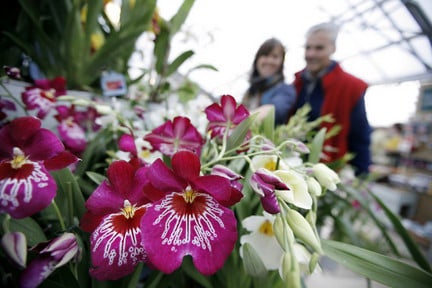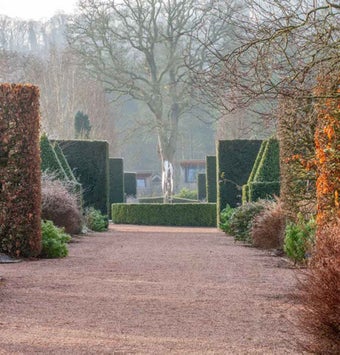
Quick facts
Suitable for - Annual bedding plants, alpines, herbs, herbaceous plants and houseplants
Timing - All year round
Difficulty - Easy
Suitable for...
This guidance will help with buying herbaceous plants, annual , alpines, herbs and seasonal houseplants. You can also find information on buying mail order plants. Selecting the best plants will make them easier to grow on.
When to buy plants in garden centres
The great thing about garden centres is that you can buy plants any time of the year when they have them available. If you intend to plant into the ground, it makes sense to also buy when planting conditions are favourable – for example, when the soil is neither frozen nor .
However, garden centres often have the best selection when plants are in flower; ceanothus in spring for example, with relatively few during other seasons.
How to buy plants from garden centres
Selecting and buying plants is not always straightforward. To make the best possible choices, consider the following before you purchase:
- Size: A larger plant doesn’t always mean a better plant. With , small compact plants will usually establish quicker and produce better-shaped specimens than those that are tall and leggy, or in flower. Conversely, you may find a huge pot of an established herbaceous that can be taken home and divided straight away before planting, giving you two plants for the price of one
- Condition: It may be fairly obvious if a plant looks of poor quality. If the foliage is dry, pale green or yellowing, or wilting, steer clear. Look for lush green foliage and a uniform pot full of growth. A well-balanced shape indicates a plant grown evenly and healthily
- Mosses, weeds and liverworts on the surface of the : These indicate a plant that has been around the garden centre for a while. Old stock like this is best avoided as the plant is also likely to be very pot bound
- Bare root: This includes plants like wallflowers. Plants should be a good size and purchased from a frost-free area on the garden centre so that their roots don’t get damaged in cold conditions. Choose plants of a uniform size and make sure they are not too wet. In the case of wallflowers, they shouldn’t have yellowing foliage or smell of rotten cabbage as this indicates poor condition
- Check the roots: Don’t be afraid to check the roots of container grown plants to ensure that the plants are not completely pot bound (in the case of herbaceous plants). Seasonal bedding plants in polystyrene trays or pots may have roots growing out of the base, which isn’t usually a problem, unless the plants have become large or floppy
- Flower : Plants in full flower may look tempting, but it’s best to select flowerless ones or, failing that, ones that still have plenty of flowers that are in tight so that you will still benefit from their display after planting. You also want the plant to be putting its energy into root and leaf growth, rather than flower growth, in the early stages
- Soil types: Take care when selecting plants for less easily cultivated soils such as chalk soils, heavy clays and dry sandy soils. For example, camellias, rhododendrons and most heathers require conditions and are intolerant of chalk and alkaline soils; in dry, gravelly soils many plants will under-perform or struggle to survive.
Make sure seasonal bedding plants are planted as soon as possible (once watered thoroughly) so that the roots can establish in the soil or potting compost. Neglected plants take longer to recover and may give a poorer performance. Remember that although you can buy half-hardy in late spring, they should not be planted outdoors until the risk of frost has passed.
When buying tropical houseplants, wrap them well before taking them out of the garden centre to protect them from sudden changes in temperature, and avoid buying plants that have obviously been chilled or have been standing in cold situations. Some houseplants (such as primulas, cyclamen and Jasminum polyanthum) are quite hardy and can be chosen from outdoor stalls, but will not like being moved to an overheated, darker room. Acclimatise houseplants to their new surroundings; try to avoid under or over watering, too hot, cold or dry an atmosphere or placing near direct heat sources, as these may lead to excessive leaf loss.

Problems
As long as the plants you buy are healthy and planted correctly, there should be relatively few problems. However, there are a few things to watch out for:
- Establishment: Good growing conditions are essential to get your plants off to the best start once planted in your garden or containers. Ensure they have adequate water, fertiliser, light and good soil to begin with, and you shouldn’t encounter many problems
- Plant Failures/Plant Guarantees: Hardy plants like herbaceous may have up to a two year plant guarantee, or sometimes even more, provided they have been planted and cultivated correctly. However, check the terms with your supplier and always keep your proof of purchase. It is usually best to discuss returns with the garden centre over the telephone before taking back the plants, as guarantees may not always be offered. For more information on plant guarantees from the RHS, see our Wisley Plant Centre
- Pest & disease: When a plant leaves a garden centre in a healthy condition and is cared for correctly it should be less susceptible to disease. However, plants will not be immune to pests, particularly flying insects such as aphids and whitefly










